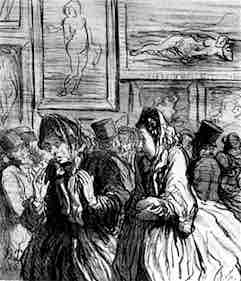Academic art is a style of painting and sculpture produced under the influence of European academies of art, more specifically, it is the art and artists influenced by the standards of the French Académie des Beaux-Arts, which practiced under the movements of Neoclassicism and Romanticism. In this context it is often called "academism", "academicism", "L'art pompier", and "eclecticism", and sometimes linked with "historicism" and "syncretism. "
Background
The Académie Royale de Peinture et de Sculpture was founded in France in 1648, and later became the Académie des Beaux-Arts. After the Académie Royale de Peinture et de Sculpture was reorganized in 1661 by Louis XIV, a controversy occurred among the members that dominated artistic attitudes for the rest of the century. This "battle of styles" was a conflict over who was a suitable model to follow—Peter Paul Rubens or Nicolas Poussin. Followers of Poussin, called "poussinistes", argued that line (disegno) should dominate art because of its appeal to the intellect, while followers of Rubens, called "rubenistes", argued that color (colore) should dominate art because of its appeal to emotion. The debate was revived in the early nineteenth century, under the movements of neoclassicism typified by the artwork of Jean Auguste Dominique Ingres, and romanticism typified by the artwork of Eugène Delacroix. Debates also occurred over whether it was better to study art by looking at nature, or to learn by looking at the artistic masters of the past. Academies using the French model formed throughout Europe, and imitated the teachings and styles of the French.
Subject Matter
The trend in academic art was towards greater idealism: contrary to realism, figures were made simpler and more abstract—idealized—in order to represent the ideals they stood in for. Hence, many paintings by academic artists are simple nature allegories with titles like Dawn, Dusk, Seeing, and Tasting, where these ideas are personified by a single nude figure, composed in such a way as to bring out the essence of the idea. This would involve both generalizing forms seen in nature, and subordinating them to the unity and theme of the artwork.
Because history and mythology were considered fertile ground for important allegory, using themes from these subjects was considered the most serious form of painting. A hierarchy of genres, originally created in the seventeenth century, was valued, where history painting—classical, religious, mythological, literary, and allegorical subjects—was placed at the top. Next came genre painting, then portraiture, still-life, and finally landscape. History painting was also known as the "grande genre. " During the reign of academic art, the paintings of the Rococo era that had previously been held in low favor were revived to popularity, and themes often used in Rococo art such as Eros and Psyche were popular again. The academic art world also idolized Raphael for the ideality of his work.

Birth of Venus
Birth of Venus, Alexandre Cabanel, 1863. Academic Art, especially in the Neoclassical period, typically used Roman and Greek allegories and simple nudes to depict idealized forms.
Salons
Academic Art exhibitions were held often. The most popular exhibition was the Paris Salon, then, beginning in 1903, the Salon d'Automne. These salons were sensational events that attracted crowds of visitors, both native and foreign. As much a social affair as an artistic one, 50,000 people might visit on a single Sunday, and as many as 500,000 could see the exhibition during its two-month run. Thousands of pictures were displayed, hung from just below eye level all the way up to the ceiling in a manner now known as "Salon style. " A successful showing at the salon was a seal of approval for an artist, making his work saleable to the growing ranks of private collectors.
Criticisms
Academic art was first criticized by realist artists for its use of idealism: based on idealistic clichés and representing mythical and legendary motives while contemporary social concerns were being ignored . Another criticism by realists was the "false surface" of paintings: the objects depicted looked smooth, slick, and idealized, showing no real texture. Similarly, perspective was constructed geometrically on a flat surface and was not really the product of sight.

"This Year, Venuses Again. "
Caricature (French bourgeoisie): This Year Venuses Again… Always Venuses!. Honoré Daumier, No. 2 from series in Le Charivati, 1864. A caricature mocking Academic Art's use of idealized form and mythical allegories, while ignoring contexts of daily or modern life.